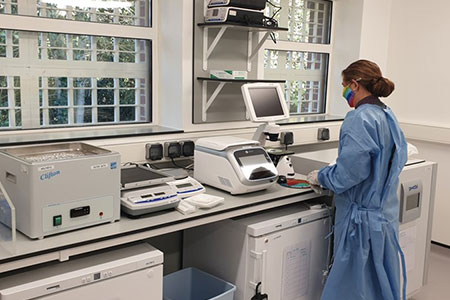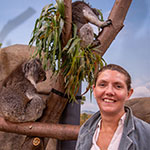A mid-career virologist’s pandemic!

Aligned with our mission to advance the understanding and impact of microbiology, the Society reached out to our community of microbiologists to share their experiences in responding to SARS-CoV-2. We aim to showcase the perspective of scientists during the COVID-19 pandemic and the variety of roles adopted to mitigate the global crisis.
This case study is written by Rachael Tarlinton, an Associate Professor in Veterinary Virology at the University of Nottingham. Her account of the pandemic expresses the challenges of teaching, supervising and researching throughout lockdowns; how the pressure of this affected many researchers’ mental health; and the media engagement duties of scientists.
Ironically my first real exposure to the COVID-19 pandemic was the Microbiology Society Virus Division planning meeting in January 2020. We covered ourselves in soothsaying glory by deciding not to have a special topic in the 2020 meeting on “this new virus in China” as it seemed under control and new virus outbreaks every year were getting boring. Turns out a room of the country’s best virologists were very wrong.
The next two years proved so frantically busy that my initial response to this case study went for six pages. I teach in a vet school and the first things to be dealt with were: shutting all our teaching down, shifting things online and then trying to get it all back up and running again in between lockdowns one and two. The students were amazingly supportive through it all but it’s safe to say that teaching clinical skills and animal handling remotely does not work.
I’m also the vet school’s Biosafety Officer, so I oversee a lot of lab safety and sit on the university’s Biosafety Committee. We had ironically just finished building a containment level 3 facility (with funding from the Wolfson foundation). Getting permission to get back into the lab and finish its commissioning was my other major challenge in the next few months, involving generating hundreds of pages of risk assessments and Standard Operating Procedures, as well as making grown builders cry on occasion.

My own research focuses on animal virology, particularly in wildlife species (including some prior work on rodent coronaviruses). This led to ending up in the Biotechnology and Biological Sciences Research Council’s (BBSRC) grant reviewers pool, serving on their strategy panel for the human–animal interface and participation in the Natural Environment Research Council's Environmental Solutions for COVID-19 workshops. Multiple grants were written and many conversations had with companies about testing their face mask coatings and air conditioning devices. Two grants I wrote as Principal Investigator with a consortia of wildlife ecologists were eventually successful with the BBSRC and we’ve been screening UK and Indian Wildlife species for SARS-CoV-2 spill over, so far with negative results.
Media engagement goes with the territory in my research area, so it wasn’t really a surprise to have multiple requests for commentary every time a new cat case in a new country or a new species was added to the (by now very long) list of animals in which cases of SARS-CoV-2 have been reported. This is one of the things where it can be easy to criticise someone’s media or social media presence, but it is a public duty (if you are the expert and don’t comment, someone with a lot less knowledge will). I don’t attract the trolling and attention from the crazy fringe of the internet that some scientists have had to endure. I’m not sure if that’s because animals are not so controversial or because I restrict my commentary and social media settings (based on previous painful experience).
Of course, like everyone else I don’t just work on coronaviruses, and eventually this pandemic (and all the research funding) will move on, so our existing work has to continue. I had two PhD students submit and pass their vivas – despite restrictions on being in the lab and access to both equipment and my time being very limited – and one whose start was delayed by over a year due to travel restrictions.
The normal processes of science were much disrupted, with my term on the Virology Division pretty much wholly consisting of online conferences (which are not the same). A much-anticipated koala retrovirus meeting at Targona Zoo (and visit home to Australia) was instead a view of a very wet sheep paddock in Sutton Bonington, a cold cup of coffee and a bunch of emails.
On a personal note, like every other working parent in the country, the closure of schools nearly killed me. Trying to keep teaching and research going (and provide pastoral care to my own students) while being a full-time primary school teacher didn’t work at all. The day of the polar bear homework: – bullying an eight-year-old into writing four lines on polar bears, while simultaneously talking a lab manager through how to stop a catastrophic water leak in the containment level 3 lab building – was a special low point. The end result was a crippling anxiety attack and a return bout of major depression requiring me to restart medication. Since returning to work properly, the numbers of colleagues who have been ‘tipped over the edge’ is heart-breaking, but entirely in keeping with the amount of pressure we’ve all been under.
So, there you have it! A mid-career virologist’s pandemic; exhilarating in bits, shatteringly difficult in others. Attempting to just keep things going and do my bit in the areas where my expertise lies was, at times, as much as could be managed. But manage we did. Here’s hoping we are better prepared for the next one!

About the author
Rachael Tarlinton is an Associate Professor in Veterinary Virology at the University of Nottingham. Her research interests focus on endogenous retroviruses and emerging viral diseases in domestic animals.
